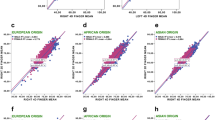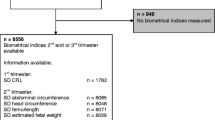Abstract
In men, the length ratio of the second to fourth finger (2D:4D) is smaller, while the length of the fourth finger relative to body height (4D:H) is larger than in women. Inter- and intrasexual variations in 2D:4D and 4D:H may depend on variation in fetal androgen and oestrogen environment. As maternal physiology varies with parity and is differentially affected by gestation of either sex, offspring 2D:4D and 4D:H may change according to sex and number of older siblings and may predict subsequent maternal performance. We analysed 2D:4D and 4D:H in Caucasian university students. 2D:4D was smaller and 4D:H was larger in males than in females, but no sexual dimorphism existed in 2D:H. In males, length ratios did not vary with birth order. 2D:4D became more masculine with increasing proportion of males among older siblings, and 2D:4D and 4D:H became more feminine as the number of older sisters increased. In females, length ratios did not vary with the number of older sisters or brothers. 2D:4D was also not related to birth order, but 4D:H became more masculine with birth order. In females, residual maternal fecundity (number of maternal offspring after the participant) decreased as 4D:H became more masculine. These findings are partly consistent with those from previous studies and suggest that maternal fecundity co-varies with length ratios and thus possibly fetal hormone environment of older offspring. 2D:4D and 4D:H may therefore represent powerful tools to investigate the relationships between fetal environment, offspring phenotype and maternal life history at mechanistic and evolutionary levels.





Similar content being viewed by others
References
Apter D, Vihko R (1990) Endocrine determinants of fertility: serum androgen concentrations during follow-up of adolescents into the third decade of life. J Clin Endocrinol Metab 71:970–974
Azziz R, Sanchez LA, Knochenhauer ES, Moran C, Lazenby J, Stephens KC, Taylor K, Boots LR (2004) Androgen excess in women: experience with over 1000 consecutive patients. Extensive personal experience. Clin Endocrinol Metab 89:453–462
Bailey AA, Hurd LH (2005) Finger length ratio (2D:4D) correlates with physical aggression in men but not in women. Biol Psychol 68:215–222
Bardin CW, Caterall CF (1981) Testosterone: a major determinant of extra-genital sexual dimorphism. Science 211:1285–1294
Becker JB, Breedlove SM, Crews D (1992) Behavioral endocrinology. MIT Press, Cambridge, MA
Bernstein L, Depue RH, Ross RK, Judd HL, Pike MC, Henderson BE (1986) Higher maternal levels of free estradiol in first compared to second pregnancy: early gestational differences. J Natl Cancer Inst 76:1035–1039
Bianchi DW, Zickwolf GK, Weil GJ, Sylvester S (1996) Male fetal progenitor cells persist in maternal blood for as long as 27 years postpartum. Proc Natl Acad Sci U S A 93:705–708
Birch RA, Padmanabhan V, Foster DL, Unsworth WP, Robinson JE (2003) Prenatal programming of reproductive neuroendocrine function: fetal androgen exposure produces progressive disruption of reproductive cycles in sheep. Endocrinology 144:1426–1434
Blanchard R (2004) Quantitative and theoretical analysis of the relation between older brothers and homosexuality in men. J Theor Biol 230:173–187
Brown WM, Finn CJ, Breedlove SM (2002a) Sexual dimorphism in digit-length ratios of laboratory mice. Anat Rec 267:231–234
Brown WM, Hines M, Fane BA, Breedlove SM (2002b) Masculinized finger length patterns in human males and females with congenital adrenal hyperplasia. Horm Behav 42:380–386
Burley NT, Foster VS (2004) Digit ratio varies with sex, egg order and strength of mate preference in zebra finches. Proc R Soc Lond B Biol Sci 271:239–244
Chandler CR (1995) Practical considerations in the use of simultaneous inference for multiple tests. Anim Behav 49:524–527
Csathò A, Osvath A, Karadi K, Bicsak E, Manning JT, Kallai J (2003) Spatial navigation related to the ratio of second to fourth digit length in women. Learn Individ Differ 13:239–249
Falconer DS, Mackay TFC (1996) Introduction to quantitative genetics, 4th edn. Longman, New York, NY
Fink B, Manning JT, Neave N (2004) Second to fourth digit ratio and the ‘Big Five’ personality factors. Pers Individ Differ 37:495–503
Gomendio M, Clutton-Brock TH, Albon SD, Guinness FE, Simpson MJ (1990) Contrasting costs of sons and daughters and the evolution of mammalian sex ratios. Nature 343:261–263
Green R (1979) Sampling design and statistical methods for environmental biologists. Wiley, New York, NY
Helle S, Lummaa V, Jokela J (2002) Sons reduced maternal longevity in preindustrial humans. Science 296:5570
Herault Y, Fradeau N, Zakany J, Duboule D (1997) Ulnaless (Ul), a regulatory mutation inducing both loss-of-function and gain-of-function of posterior Hoxd genes. Development 124:3493–3500
Holm S (1979) A simple sequentially rejective multiple test procedure. Scand J Statist 6:65–70
James WH (1996) Evidence that mammalian sex ratios at birth are partially controlled by parental hormone levels at the time of conception. J Theor Biol 180:271–286
James WH (2001) Finger-length ratios, sexual orientation and offspring sex ratios. J Theor Biol 212:273–274
Kondo T, Zakany J, Innis J, Duboule D (1997) Of fingers, toes and penises. Nature 390:29
Leoni B, Canova L, Saino N (2005) Sexual dimorphism in metapodial and phalanges length ratios in the wood mouse. Anat Rec 286A:955–961
Lippa RA (2003) Are 2D:4D finger-length ratios related to sexual orientation? Yes for men, no for women. J Pers Soc Psychol 85:179–188
Lutchmaya S, Baron-Cohen S, Raggatt P, Knickmeyer R, Manning JT (2004) 2nd to 4th digit ratios, fetal testosterone and estradiol. Early Hum Dev 77:23–28
Mace R, Sear R (1997) Birth interval and the sex of children in a traditional African population: an evolutionary analysis. J Biosoc Sci 29:499–507
Manning JT (2002) Digit ratio. Rutgers University Press, New Brunswick, NJ
Manning JT, Taylor RP (2001) Second to fourth digit ratio and male ability in sport: implications for sexual selection in humans. Evol Hum Behav 22:61–69
Manning JT, Scutt D, Wilson J, Lewis-Jones DJ (1998) The ratio of 2nd to 4th digit length: a predictor of sperm number and levels of testosterone, LH and oestrogen. Hum Reprod 13:3000–3004
Manning JT, Martin S, Trivers RL, Soler M (2002) 2nd to 4th digit ratio and offspring sex ratio. J Theor Biol 217:93–95
Manning JT, Callow M, Bundred PE (2003) Finger and toe ratios in humans and mice: implications for the aethiology of diseases influenced by HOX genes. Med Hypotheses 60:340–343
Margulis SW, Altmann J, Ober C (1993) Sex-biased lactational duration in a human population and its reproductive costs. Behav Ecol Sociobiol 32:41–45
McFadden D, Bracht MS (2003) The relative lengths and weights of metacarpals and metatarsals in baboons (Papio hamadryas). Horm Behav 43:347–355
McFadden D, Bracht MS (2005) Sex differences in the relative length of metacarpals and metatarsals in gorillas and chimpanzees. Horm Behav 47:99–111
McFadden D, Shubel E (2002) Relative lengths of finger and toes in human males and females. Horm Behav 42:492–500
McFadden D, Loehlin JC, Breedlove SM, Lippa RA, Manning JT, Rahman Q (2005) A reanalysis of five studies on sexual orientation and the relative length of the 2nd and 4th fingers (the 2D:4D ratio). Arch Sex Behav 34:341–356
Micheli A, Muti P, Pisani P, Secreto G, Recchione C, Totis A, Fissi R, Cavalleri A, Panico S, Berrino F (1991) Repeated serum and urinary androgen measurements in premenopausal and postmenopausal women. J Clin Epidemiol 44:1055–1061
Miller EM (1994) Prenatal sex hormone transfer: a reason to study opposite-sex twins. Pers Individ Differ 17:511–529
Miller EM (2000) Homosexuality, birth order, and evolution: toward an equilibrium reproductive economics of homosexuality. Arch Sex Behav 29:1–34
Mortlock DP, Innis JW, Post LC (1996) The molecular basis of hypodactyly (Hd), a deletion in Hoxa13 leads to arrest of digital arch formation. Nat Genet 13:284–289
Nakagawa S (2004) A farewell to Bonferroni: the problems of low statistical power and publication bias. Behav Ecol 15:1044–1045
Neave N, Laing S, Fink B, Manning JT (2003) Second to fourth digit ratio, testosterone, and perceived male dominance. Proc R Soc Lond B Biol Sci 270:2167–2172
Okten A, Kalyoncu M, Yaris N (2002) The ratio of second- and fourth-digit lengths and congenital hyperplasia due to 21-hydroxylase deficiency. Early Hum Dev 70:47–54
Panagiotopoulou K, Katsouyanni K, Petridou E, Garas Y, Tzonou A, Trichopoulos D (1990) Maternal age, parity, and pregnancy estrogens. Cancer Causes Control 1:119–124
Peichel CL, Prabhakaran B, Voght TF (1997) The mouse Ulnaless mutation deregulates posterior HoxD gene expression and alters appendicular patterning. Development 124:3481–3492
Peters M, Mackenzie K, Bryden P (2002) Finger length and distal finger extent patterns in human. Am J Phys Anthropol 117:209–217
Putz DA, Gaulin SJC, Sporter RJ, McBurney DH (2004) Sex hormones and finger length. What does 2D:4D indicate? Evol Hum Behav 25:182–199
Rahman Q, Wilson GD (2003) Sexual ornamentation and the 2nd to 4th finger length ratio: evidence for organizing effects of sex hormones or developmental instability? Psychoneuroendocrinology 28:288–303
Reznikov G, Sinitsyn PV, Tarasenko LV, Polyakova LI (2003) Neuroendocrine mechanisms of development of experimental hyperandrogen-induced anovulation. Neurosci Behav Physiol 33:773–776
Rice WR (1989) Analyzing tables of statistical tests. Evolution 43:223–225
Robinson SJ, Manning JT (2000) The ratio of 2nd to 4th digit length and male homosexuality. Evol Hum Behav 21:333–345
Robinson JE, Birch RA, Foster DL, Padmanabhan V (2002) Prenatal exposure of the ovine fetus to androgens sexually differentiates the steroid feedback mechanisms that control gonadotropin releasing hormone secretion and disrupts ovarian cycles. Arch Sex Behav 31:35–41
Romano M, Leoni B, Saino N (in press) Examination marks of male university students positively correlate with finger length ratios (2D:4D). Biol Psychol
Romano M, Rubolini D, Martinelli R, Bonisoli Alquati A, Saino N (2005) Experimental manipulation of yolk testosterone affects digit length ratio in the ring-necked pheasant (Phasianus colchicus). Horm Behav 48:342–346
Roney JR, Whitham JC, Leoni M, Bellem A, Wielebnowski N, Maestripieri D (2004) Relative digit lengths and testosterone levels in Guinea baboons. Horm Behav 45:285–290
Rosenthal R, Rosnow RL, Rubin DB (2000) Contrasts and effect sizes in behavioral research. Cambridge University Press, Cambridge
Ryan BC, Vandenbergh JG (2002) Intrauterine position effects. Neurosci Biobehav Rev 26:665–678
SAS Institute (1989) SAS/STAT user’s guide, version 9.0. SAS Institute, Cary, NC
Sir-Petermann T, Devoto L, Maliqueo M, Peirano P, Recabarren SE, Wildt L (2001) Resumption of ovarian function during lactational amenorrhoea in breastfeeding women with polycystic ovarian syndrome: endocrine aspects. Hum Reprod 16:1603–1610
Sir-Petermann T, Maliqueo M, Angel B, Lara HE, Pérez-Bravo F, Recabarren SE (2002) Maternal serum androgens in pregnant women with polycystic ovarian syndrome: possible implications in prenatal androgenization. Hum Reprod 17:2573–2579
Sullivan SD, Moenter SM (2004) Prenatal androgens alter GABAergic drive to gonadotropin-releasing hormone neurons: implications for a common fertility disorder. Proc Natl Acad Sci U S A 101:7129–7134
vom Saal FS (1989) Sexual differentiation in litter-bearing mammals: influence of sex of adjacent fetuses in utero. J Anim Sci 67:1824–1840
Williams TJ, Pepitone ME, Christensen SE, Cooke BM, Huberman AD, Breedlove NJ, Breedlove TJ, Jordan CL, Breedlove SM (2000) Finger-length ratios and sexual orientation. Nature 404:455–456
Wolf FM (1986) Meta-analysis: quantitative methods for research synthesis. Quantitative applications in the social sciences series, vol 59. Sage Publications, Thousand Oaks, CA
Wright SP (1992) Adjusted P-values for simultaneous inference. Biometrics 48:1005–1013
Zar JH (1999) Biostatistical analysis, 4th edn. Prentice-Hall, Upper Saddle River, NJ
Acknowledgement
The present study comply with the Italian current laws. We thank John T Manning for valuable comments on an earlier version of the manuscript.
Author information
Authors and Affiliations
Corresponding author
Additional information
Communicated by T. Czeschlik
Rights and permissions
About this article
Cite this article
Saino, N., Leoni, B. & Romano, M. Human digit ratios depend on birth order and sex of older siblings and predict maternal fecundity. Behav Ecol Sociobiol 60, 34–45 (2006). https://doi.org/10.1007/s00265-005-0137-1
Received:
Revised:
Accepted:
Published:
Issue Date:
DOI: https://doi.org/10.1007/s00265-005-0137-1




